SERCOS Axis
”SERCOS Drive” tab
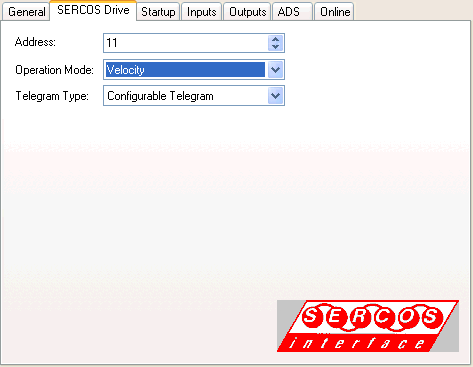
Address: SERCOS axis address which must be the same as the one on the drive amplifier.
Operating mode: Sets the SERCOS operating mode for the axis. It supports the speed operating mode (velocity control) in which speed command values are sent to the drive and the position control mode.
Operating mode | Description |
|---|---|
Velocity | The drive receives digital velocity setpoints, which are generated by the TwinCAT NC controller on the PC. |
Position 1 | The drive receives digital position setpoints cyclically generated by TwinCAT NC. The loop is closed by the drive. The motor resolver provides actual position values (Position 1, Resolver, S-0-0051). |
Position 2 | The drive receives digital position setpoints cyclically generated by TwinCAT NC. The loop is closed by the drive. An external encoder provides actual position values (Position 2, S-0-0053). |
Position 1+2 | The drive receives digital position setpoints cyclically generated by TwinCAT NC. The loop is closed by the drive. Actual position feedback is provided from external encoder and from Resolver. |
Position 1 without Lag | Drive-internal interpolation (drive is deployed without linkage to TwinCAT NC controller). The motor resolver provides actual position values (Position 1, Resolver, S-0-0051). |
Position 2 without Lag | Drive-internal interpolation (drive is deployed without linkage to TwinCAT NC controller). An external encoder provides actual position values (Position 2, S-0-0053). |
Position 1+2 without Lag | Drive-internal interpolation (drive is deployed without linkage to TwinCAT NC controller). Actual position feedback is provided from external encoder and from Resolver. |
Notice | |
In the positioning operating mode, ensure that, if using a loop axis in the weighting mode for position data (S-0-0076), the modulo function is switched on and the resulting modulo value (S-0-0103) is recognized in TwinCAT (see ”SERCOS" tab). |
Notice | |
In speed operating mode, ensure that the output scaling for the drive is set correctly in the TwinCAT system (see ”SERCOS" tab). |
Telegram type: Sets the telegram structure to/from the drive. The "Configurable telegram" type is selected by default (see following table).
Telegram type | Description |
|---|---|
Preferred telegram 1 (80 / -) | The telegram to the drive only contains the torque setpoint (IDN 80). There is no return telegram from the drive with this telegram type. |
Preferred telegram 2 (36 / 40) | Telegram to drive: Velocity setpoint (IDN 36) Telegram from drive: Actual speed value (IDN 40) |
Preferred telegram 3 (36 / 51) | Telegram to drive: Velocity setpoint (IDN 36) Telegram from drive: Actual position value (IDN 51) |
Preferred telegram 3 ext. (36 / 53) | Telegram to drive: Velocity setpoint (IDN 36) Telegram from drive: Actual position value from external encoder (IDN 53) |
Preferred telegram 4 (47 / 51) | Telegram to drive: Position setpoint (IDN 47) Telegram from drive: Actual position value (IDN 51) |
Preferred telegram 4 ext. (47 / 53) | Telegram to drive: Position setpoint (IDN 47) Telegram from drive: Actual position value from external encoder (IDN 53) |
Preferred telegram 5 (47 36 / 51 40) | Telegram to drive: Position and speed setpoint value Telegram from drive: Actual position and speed value |
Preferred telegram 5 ext. (47 36 / 53 40) | Telegram to drive: Position and speed setpoint value Telegram from drive: Position (external encoder) and speed actual value |
Preferred telegram 6 (36 / -) | The telegram to the drive only contains the speed setpoint (IDN 36). There is no return telegram from the drive with this telegram type. |
Configurable telegram | A custom telegram configuration with all desired setpoints and actual values can be executed. |
 | The calculation described for the FC750x in the "Timing Offline" tab area assumes a basic telegram type (telegram type 2-4). |
”Startup” tab
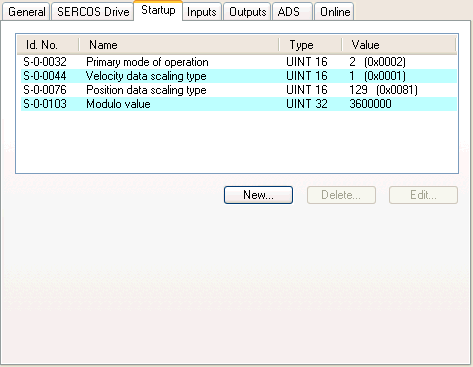
In this case SERCOS parameters can be set here which are sent to the drive at every TwinCAT StartUp via the NC service channel and which overwrite the existing drive values.
”Inputs” tab
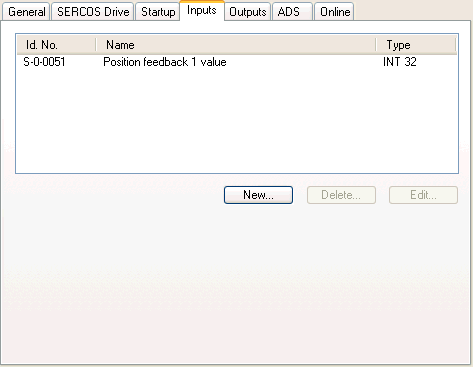
Under "Inputs" (Actual Channel) all necessary and optional SERCOS parameters which come from the drive fin this case, are listed. Corresponding variables are automatically created below the axis in the tree view. These can be linked accordingly.
A position feedback value is required in all cases!
New...: After hitting this button, additional variables can be inserted into the cyclical receive telegram from the drive:
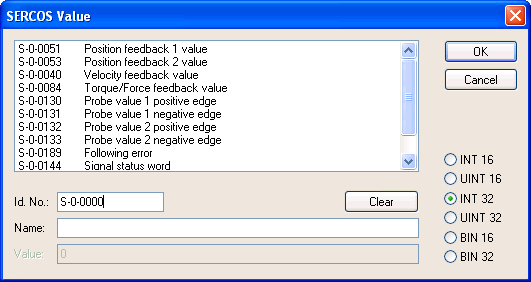
At Id. No., a supported IDN of the drive can be entered. Name is an edit field for a descriptive name for the IDN (suggested parameters from above shown list will fill this name field automatically). Additionally, Accordingly, the appropriate data type for the wished IDN has to be selected from the list, shown on the right.
”Outputs” tab
Variables, which must be transmitted to the drive, are specified here as in the "Outputs". Depending upon the axis operating mode, the list on this tab must contain the "Velocity command value" or the "Position command" value. Further parameters can be added in the same way as under "Inputs" here.
”ADS” tab
The ADS port number, via which all ADS access to the internal drive parameters takes place, is entered here at the ADS tab.
”Online” tab
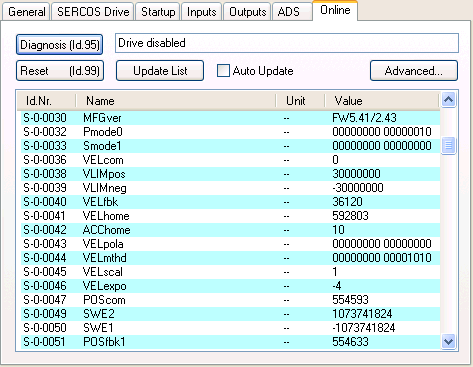
The NC service channel can be served via the online tab. TwinCAT must be started for this to take place and the SERCOS ring must be in at least phase 2.
Diagnosis: After a click on this button, updated diagnostic information (see also S-0-0095) will be displayed on the field right next to it.
Reset: After a click on this button, the axis and or amplifier reset will take place (see also S-0-0099).
The list below shows all SERCOS parameters with current values. This data is read from the drive online (incl. text and units) which means that scrolling through the list takes some time. If the drive supports this function, you can choose between English and German output.
Change the parameters by double-clicking on the relevant ID no. to display a corresponding dialogue.
Context menu:
The list of SERCOS parameters may also be printed and exported (includes via drag and drop e.g. in Excel). Right click with the mouse to open a corresponding context menu:
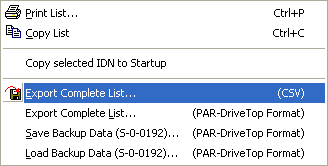
Print List: Output of list on printer
Copy List: Copies the list into the Windows Clipboard
Copy selected IDN to Startup: If aktive, the selected IDN can be added to the Startup parameters here.
Export Complete List (CSV): After exporting the variable into a *.csv file (= omma eparated aluescsv), the parameters could be further used in applications which support this file format (e.g. MS Excel).
Export Complete (PAR): Exports the parameters into the DriveTop compatible *.par file format.
Update List: Click on this button to reload the currently viewed values from the drive.
Auto Update: Check this box to initiate a regular timed update (update rate approx. 2sec.).
Advanced: After a click on this button, the following dialog for the "Advanced Online Settings" comes up:
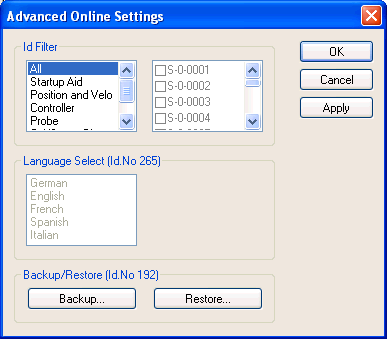
The upper left-hand list box allows you to place thresholds on the values displayed in the list on the "Online" tab. The system suggests a series of groups which define associated values in certain contexts. The last group on the list is a user-defined group. Any combination can be created in the right-hand list in this case.
Backup / Restore: These two buttons are used to save the parameters defined by the drive (see also S-0-0192) to a (backup) file and subsequently reload those parameters into a replacement drive (restore). The format of the backup file corresponds to the parameter format (*.par), which is used by the DriveToptool supplied by company Rexroth-Indramat. This enables you to carry out data exchange using this tool.
SERCOS IDs via ADS
SERCOS IDs can also be read and written (e.g. from the PLC) during runtime via ADS. In this case the axis must be allocated an ADS port via the ADS tab. This takes place as standard.
ADS read/write requests can be executed via this port. The IndexGroup corresponds to the required SERCOS IDN and the IndexOffset to the element of the SERCOS value:
Port No.: Number shown on "ADS" tab (see above)
IndexGroup: SERCOS ID, e.g.:
S-0-0123 = 123 (0x007B)
S-7-0101 = 101 + 0x7000 = 0x7065
P-0-0002 = 2 + 0x8000 = 0x8002
P-7-0004 = 4 + 0x8000 + 0x7000 = 0xF004
IndexOffset: Required element:
0 or 7 = value,
1 = Data Status,
2 = Name (read only),
3 = Attribute (see SERCOS specification),
4 = Unit,
5 = Minimum,
6 = Maximum
Reset via ADS
The drive amplifier can be reset (e.g. after exceeded max. lag-distance) via ADS. To the SERCOS IDN S-0-0099 an ADSWrite command (or sequence) has to be sent. The command varies depending on the used SERCOS master card
a drive reset can be achieved if to IndexGroup: 0x0063, IndexOffset: 8, a 3 is send ("ByRef", that means in this case: The address of a constant 3 has to be passed on to SrcAddr).
or at a
- SERCANS SCS-P Master card:
if the values 3, 0, 3 and 0 again, are sent "ByRef" (SrcAddr) one after another to IndexGroup: 0x0063, IndexOffset: 7.
(By the way, this is done internally by the TwinCAT System Manager, if you press the "Reset" button on the "Online" tab).
Diagnosis Inputs
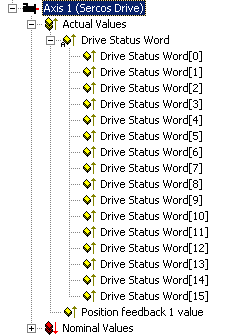
The Drive Status Word is a SERCOS specific return telegram, all SERCOS drives have to provide.
Variable | Data type | Bit | Description |
|---|---|---|---|
Drive Status Word | UINT16 | 0..2 | Control information for service channel |
5 | Bit change command | ||
6+7 | Real time status bits 1 + 2 | ||
8+9 | Actual type of operation 00: Main type of operation active | ||
11 | Bit change class 3 diagnostics | ||
12 | Bit change class 2 diagnostics | ||
13 | Drive lock, error in class 1 diagnostics | ||
14+15 | Ready to operate 00: Drive not ready for power on, since internal checks aren't finished positively |